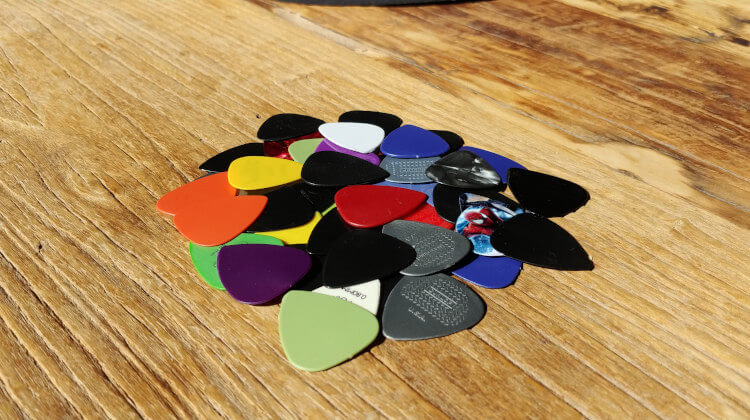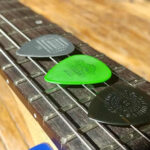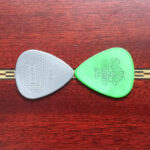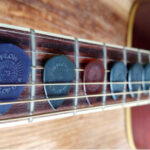
Guitar picks come in a wide variety of shapes, materials, and thicknesses, which affects the way a guitarist strikes the strings. But a pick (or plectrum) does more than change feel of the instrument, it also changes the tone.
While many guitarists use subjective terms such as ‘warm’ or ‘bright’ to describe the impact of different picks, one scientific study has quantified exactly how by measuring amplitude, decay and harmonic richness.
The University of Music and Performing Arts Vienna study by Sandra Carral measured the differences between thin (0.46mm), medium (0.96mm) and heavy (2.00mm) Dunlop Delrin picks.
These are generally the standard thickness for picks, although it should be noted there’s no real science behind standard guitar pick gauges. In the 1960s the first guitar pick manufacturer, D’Andrea, sliced the thickness of its thin, medium and heavy-gauge picks by 0.0508mm (0.002 inch) to boost profit margins, according to Will Hoover’s book Picks!
The result was a new measurement for thin (0.46mm or 0.028 inch), medium (0.71mm or 0.038 inch), and thick (96mm or 0.018 inch) picks. (In the 1970s, D’Andrea added three additional gauges: 58mm, 84mm, and 1.21mm.)
The University of Music and Performing Arts Vienna study was standardized so that each pick struck the open E and open G strings on a Larrivee LV-03RE steel-string acoustic fitted with a pickup. The sound was recorded with an AKG C414 microphone and hooked up to Sony Sound Forge Audio Studio software. An artificial plucking machine ensured each pick struck the guitar string with equal force and in the same position.
A thicker guitar pick generates a mellower sound, longer decay on the open E string
The sound of the open E string changed the most depending on the pick used, according to the study results.
While the initial amplitude of all picks was the same after being struck, the sound produced by the thin pick decayed faster than the two thicker picks. In fact, after two seconds the amplitude of the thin plectrum was eight decibels lower than the other two.
The harmonic nature of the open E note also changed depending on the pick used. The thin plectrum had the most of its energy in harmonics two, three and four whereas the thick pick produced more energy in the fundamental note.
“A thick plectrum will generate a mellower sound compared to a thin one,” the study found.
Some notable and surprising guitarists use the ultra thick Dunlop Delrin 500 2.0mm pick. Funk guitarist Mike Scott, who has played with Prince and Justin Timberlake, told Guitar Player magazine he used the pick with DR Strings (.010″-.046″) in May 2007. Meanwhile, former The Police guitarist Andy Summer also said he used the same pick to play the first riff on his song Levitation.
“I play most of that song with a pick, but on most of my new material I generally go back and forth between using a little Dunlop Delrin 500 2mm pick, and full right-hand plucking,” he told Guitar Player in 2014. “Strumming with a pick sounds great if you’re hitting power chords aggressively, but my chords sound better when they are plucked rather than simply strummed with a pick.”
A thinner guitar pick generates quieter notes, less pitch distortion on the open G string
Different picks applied with the same force also produced different amplitudes across the open G string.
The thin pick produced a quieter sound, which was 10 decibels lower than the medium and thick picks at the beginning of the sound and about 5 decibels lower at the end of the sound. However, the note decayed at the same pace despite which pick was used.
But whereas a thick plectrum generated a mellower sound on the open E string, the tests showed no such noticeable effect on the open G.
When a string is struck, the pitch of the fundamental note is significantly distorted for 100-200 milliseconds as energy flows through it. However, the study suggests that the thickness of the pick, as well as the physical attributes of the string, might define how fast and how far the pitch falls.
The study found that thin pick distorted the open G note about half as much as a medium or thick pick (150 cents versus 300 cents – or 1.5 semitones versus 3 semitones). This distortion also occurred faster on the open E string compared to the open G for all three picks used.
“This suggests that both the thickness of the plectrum and the physical attributes of the string might define when and how low the pitch will fall,” the study found.






Lessons for guitarists when choosing a pick
Striking a guitar string with a pick affects the sound in four ways that a guitarist can control:
- The plucking position along the string.
- The initial displacement of the string (which is related to the plucking force).
- The way the string deforms after being released (which is related to the characteristics of the pick).
- The direction of the plucking.
This study shows that not only does the thickness of a pick plays a substantial role, but also that wound and unwound strings respond quite differently. Other tests have found similarly strong differences between wound and unwound strings.
It confirms some subjective notions that guitarists hold: that thin picks tend to produce a brighter and thinner sound compared to thicker picks (at least on wound strings). Thinner picks also tend to produce a quieter sound (even when hitting the strings with the same force as a thicker pick) presumably because thinner picks bend and absorb some of this energy.
A separate study by the Victoria University of Wellington put it another way: “Thicker picks give a much deeper sound due to a larger fundamental than the thinner picks of the same material. Higher harmonics are heard easier with the thinner picks as the fundamental is not as dominant.”






